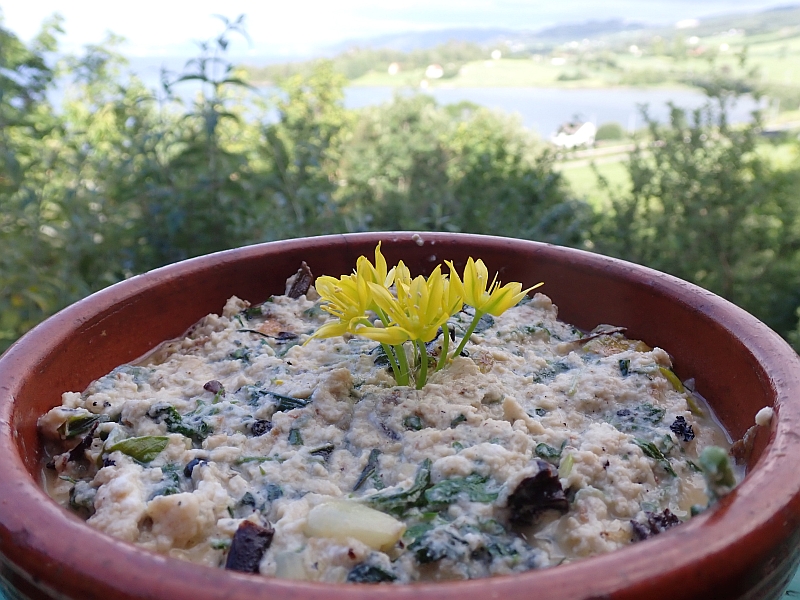On 30th June 2025, I made ryotto with various perennial vegetables available in the garden. The ryotto is stir-fried veg mixed with wholegrain organic rye with chili and a strong Norwegian organic blue cheese. In the video I talk you through the various greens:
Daubenton perennial kale
Allium wallichii (Sherpa onion / Nepal onion)
Rudbeckia laciniata (top shoots)
Cryptotaenia japonica “Atropurpurea” (purple mitsuba)
Aster microcephalus (Aster ovatus) top shoots
Hemerocallis dumortieri and Hemerocallis lilioasphodelus (flower buds)
Allium moly flower clusters
Hosta – leaves of 2 varieties plus a flower shoot
2nd batch:
Urtica dioica and Urtica kiovensis (stinging nettles)
Hablitzia tamnoides (Caucasian spinach) summer leaves
Diplotaxis tenuifolia (perenial rocket)
Heracleum sp. (hogweed) flower shoot
Bay leaves
Watercress
Crambe maritima (flower clusters and young leaves)
Sorrel “Profusion” and “Abundance”
See the video via the link:
https://youtu.be/omgOqJhTVQ4




Category Archives: Food
Green catch of the day!
Today’s veg! Names below the pictures (mostly top shoots and scapes). Plants:
Plants:
Heracleum flower shoots (cow parsley / bjørnekjeks)
Urtica dioica (stinging nettle / brennesle)
Cryptotaenia japonica “Atropurpurea” (purple mitsuba)
Allium fistulosum (Welsh onion / pipeløk)
Myrrhis odorata (sweet cicely / spansk kjørvel)
Campanula trachelium (nettle-leaved bellflower / nesleklokke)
Campanula latifolia (giant bellflower / storklokke)
Diplotaxis tenuifolia (perennial rocket / flerårig rucola)
Hosta (2 varieties)
Allium wallichii (Sherpa onion / Sherpaløk); spring shoots
Hemerocallis dumortieri (flower buds)
Hemerocallis lilioasphodelus (flower buds)
Tragopogon pratensis (Jack-go-to-bed-at-noon / geitskjegg)
Seasonal leafy greens
For a quick Mediterranean diet inspired scrambled egg, aka scrambled greens, these were the diversity of perennial greens I could quickly forage in my garden in about 5 minutes (names at the bottom):
Plus these St. George’s Mushrooms (vårfagerhatt) which are still available: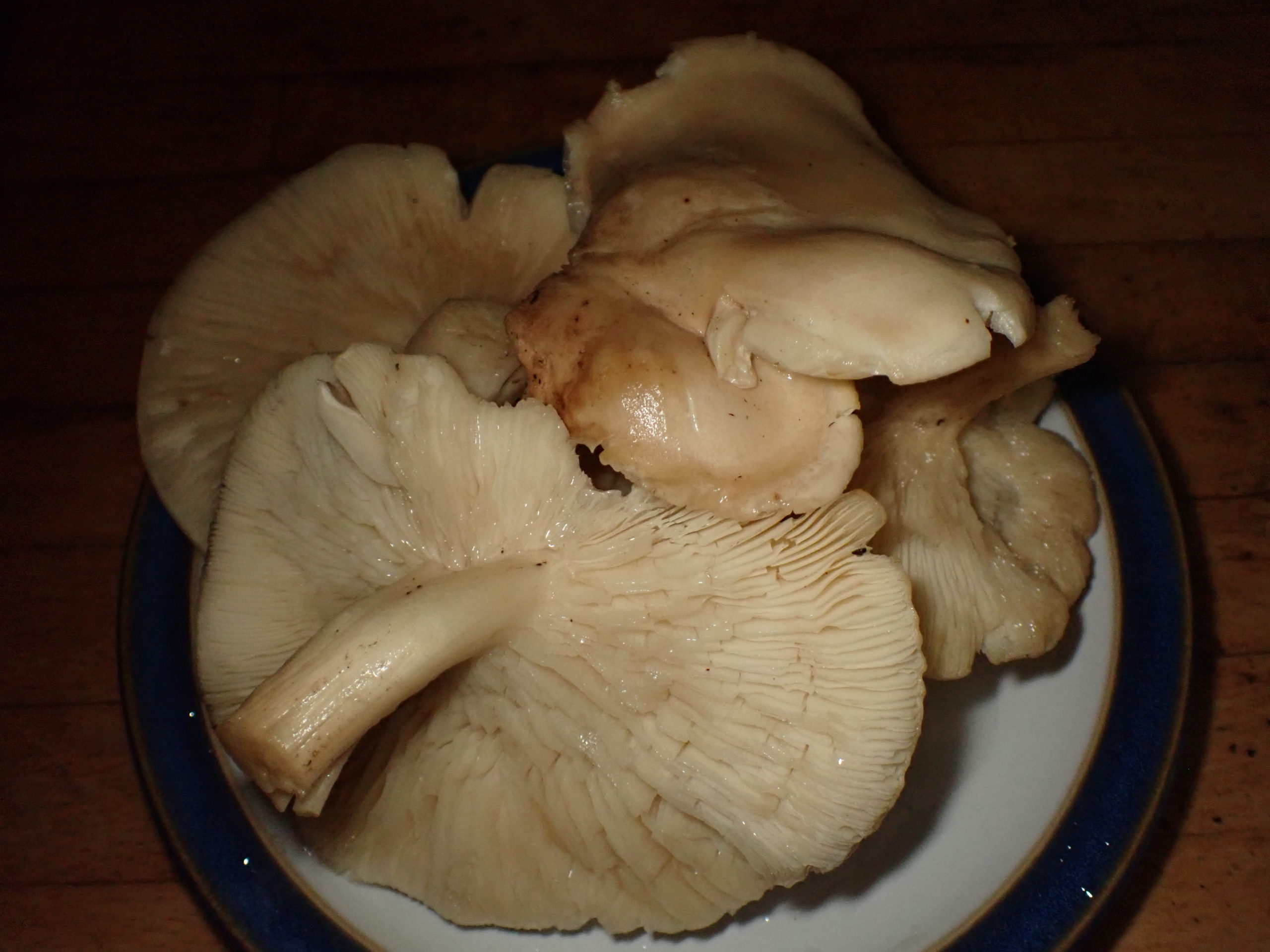
…and the scrambled greens (fast slow food!):
The 22 greens:
1. 3 different Hostas
2. Heracleum sibiricum (Siberian hogweed; sibirbjørnekjeks); flowering shoots
3. Heracleum maximum (cow parsnip); flowering shoots
4. Brassica oleracea (perennial kale; flerårige kål); broccolis
5. Lepidium latifolium (dittander; strandkarse); top shoots
6. Rumex acetosa “Abundance” (non-flowering sorrel; engsyre)
7. Allium scorodoprasum (sand leek; bendelløk)
8. Campanula latifolia (giant bellflower; storklokke); top shoots
9. Campanula trachelium (nettle-leaved bellflower; nesleklokke); top shoots
10. Campanula rapunculoides (creeping bellflower; ugressklokke); top shoots
11. Urtica kiovensis; top shoots
12. Urtica dioica (stinging nettle; brennesle); top shoots
13. Aster komena; top shoots
14. Oenanthe javanica (seri)
15. Bunias orientalis (Turkish rocket; russekål); broccolis
16. Allium nutans
17. Diplotaxis tenuifolia (perennial rocket; flerårig rucola)
18. Allium ochotense (asiatic victory onion; asiatisk seiersløk)
19. Phyteuma nigra (black rampion; svartvadderot)
20. Malva alcea (hollyhock mallow; rosekattost)
St. George’s Mushrooms and Sand Leek


Two gourmet ingredients (and many more) for tonight’s green pasta sauce are just doing their own thing in my edible garden with little interference from me, apart from the picking. First the patch of St. George’s Mushroom (vårfagerhatt; Calocybe gambosa) growing under a large birch tree next to a large patch of nettles and then sand leeks (bendelløk; Allium scorodoprasum) which self-sow from bulbils on the seakale bed (strandkål; Crambe maritima) in the seaweed mulch. The St George’s mushrooms are growing to the right of the chair
The St George’s mushrooms are growing to the right of the chair  The seakale / strandkål bed is full of sandleeks / bendelløk
The seakale / strandkål bed is full of sandleeks / bendelløk
A 70 permaveggie Fus-Cheese!
To celebrate that the life-timer clicked over from 69 to 70 yesterday, the Barstow household’s tradition of making an equi-age permaveggie diversity MacCheese for dinner was followed once again, except we were out of macaroni and it was therefore a 70 species FusCheese with whole grain Fusili pasta! Curious as to what was in it, please see the plant ingredient list below the pictures:
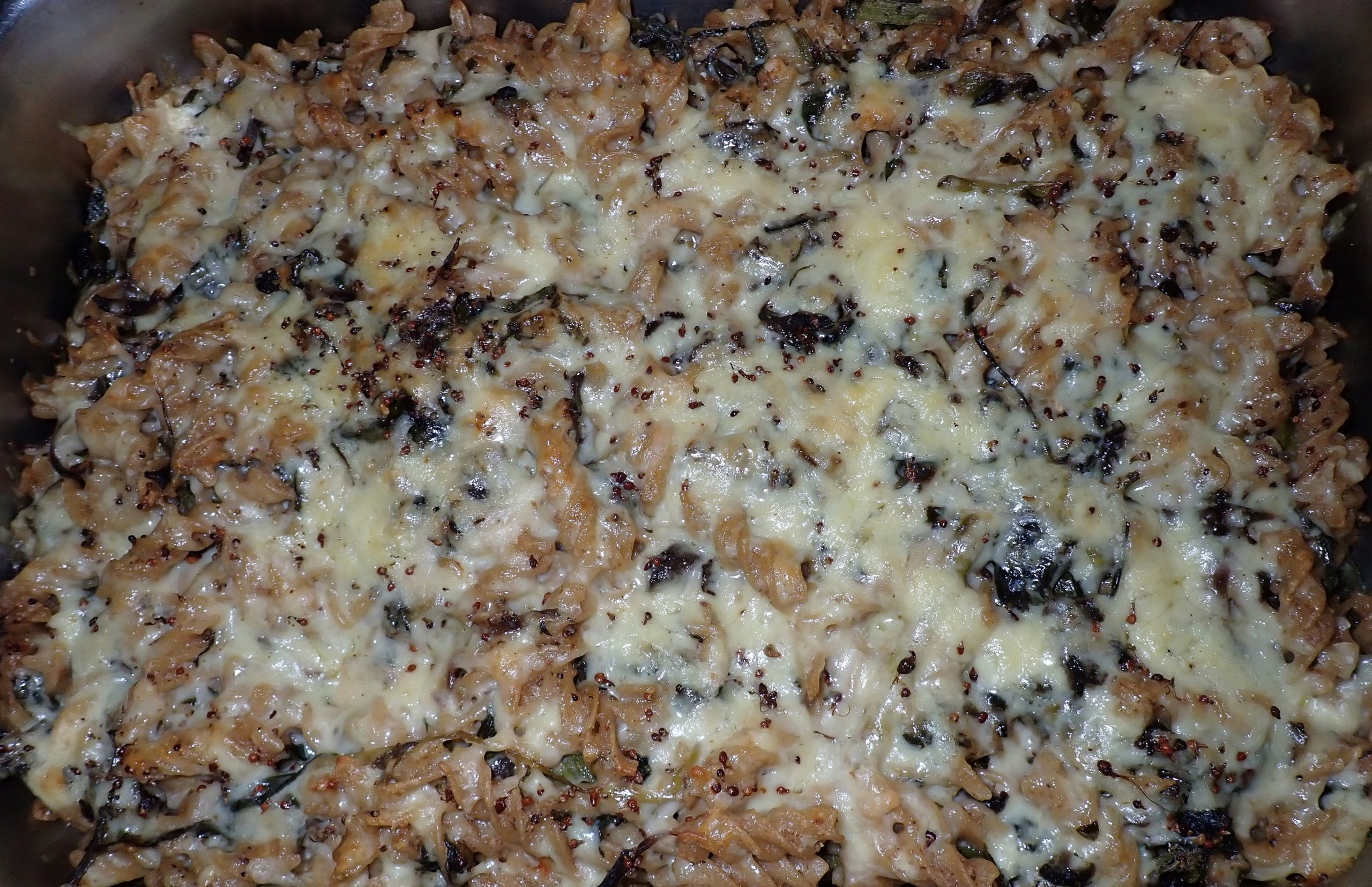
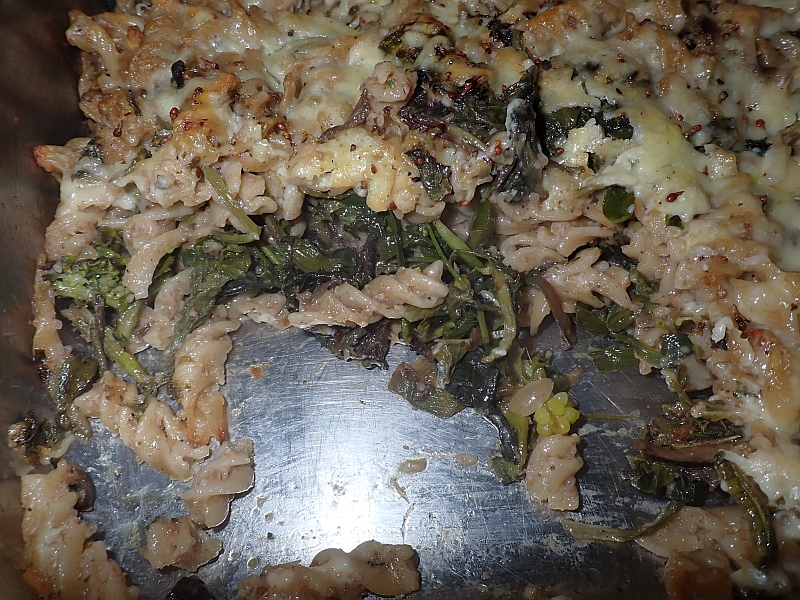
Ingredients list:
Agastache foeniculum ; Anise Hyssop; Anisisop
Agastache foeniculum Aureum; Golden Anise Hyssop; Anisisop
Allium angulosum x nutans “Norrlandsløk”; Norrland onion; Norrlandsløk
Allium cernuum Pink Giant
Allium cernuum White Dwarf
Allium douglasii; Douglas’ onion; Douglas-løk
Allium fistulosum “Nedre Gjetsiden”; Welsh onion; Takløk fra Gudbrandsdalen
Allium hymenorhizum
Allium nutans ; Blue Chives; Sibirsk nikkeløk
Allium ochotense ; Japanese victory onion; Seiersløk
Allium paradoxum var paradoxum; Few-flowered Leek
Allium pskemense x fistulosum; Wietse’s onion; Wietsesløk
Allium sativum ; Garlic ; Hvitløk
Allium schoenoprasum Dwarf White; Chives; Gressløk
Allium tricoccum; Ramps
Allium validum; Swamp Onion; Stillehavsløk
Allium victorialis “Nordland” ; Victory onion; Seiersløk
Allium x cornutum ; St. John’s onion ; Johannesløk
Allium x proliferum “Dømmesmoen”; Walking onion; Luftløk
Angelica archangelica ssp archangelica v. Majorum “Vossakvann Markusteigen”; Angelica; Vossakvann
Anthriscus cerefolium ; Chervil; Hagekjørvel
Anthriscus sylvestris “Golden Fleece”; Cow parsley; Hundekjeks
Arabis alpina; Alpine rock cress; Fjellskrinneblom
Aralia californica; Elk clover; California-udo
Aralia elata; Japanese Angelica tree, Devil’s walking stick; Fandens spaserstokk
Artemisia dracunculus sativa “German”; German Tarragon; Tysk estragon
Aster yomena
Aster microcephalus
Aster scaber; Korean aster; Korea-asters
Barbarea vulgaris ssp vulgaris; Yellow Rocket/Wintercress; Vinterkarse
Bistorta officinalis; Bistort; Ormerot
Campanula trachelium; Nettle-leaved Bellflower/ Bats in the Belfry; Nesleklokke
Cardamine raphanifolia
Chamerion angustifolium; Rosebay Willowherb; Geitrams
Chenopodium bonus-henricus; Good King Henry; Stolt Henrik
Cirsium canum; Queen Anne’s Thistle; Droning Annes tistel
Cirsium oleraceum; Siberian Thistle/Cabbage Thistle; Kåltistel
Cirsium setidens
Crambe maritima; Sea kale; Strandkål
Cryptotaenia canadensis; Honewort
Cryptotaenia japonica Atropurpurea; Purple mitsuba; Lilla-mitsuba
Dystaenia takesimana ; Ulleung giant celery; Uleungkjempeselleri
Hemerocallis altissima; Daylily; Daglilje
Hemerocallis citrina; Daylily; Daglilje
Hemerocallis dumortieri; Daylily; Daglilje
Hemerocallis middendorfii; Daylily; Daglilje
Hemerocallis spp.; Daylily; Daglilje
Hemerocallis spp.; Daylily; Daglilje
Heracleum sphondylium ; Hogweed; Kystbjørnekjeks
Heracleum sphondylium “Pink flowered”; Hogweed; Kystbjørnekjeks
Hosta spp.; Hosta ; Hosta
Hosta spp.; Hosta ; Hosta
Humulus lupulus Aureus ; Golden Hops; Gullhumle
Hydrophyllum tenuipes; Pacific waterleaf; Stillehavs-vassblad
Hydrophyllum virginianum; Eastern Waterleaf; Virginia Waterleaf; Virginia-vassblad
Lepidium latifolium ; Dittander; Strandkarse
Levisticum officinale “Ullershov”; Lovage; Løpstikke
Ligularia fischeri; Fischer’s Ligularia; Fischersnøkketunge
Ligusticum hultenii; Hulten’s lovage; Hultens strandkjeks
Oenanthe javanicum; Seri ; Seri
Phyteuma nigrum ; Black rampion; Svartvadderot
Plantago major “Atropurpurea”; Greater Plantain; Groblad
Primula veris ; Cowslip; Marinøkleblom
Rudbeckia laciniata ; Cutleaf Coneflower; Gjerdesolhatt, kyss-meg-over-gjerde, sochan
Rumex patientia; Herb Patience; Hagesyre
Saxifraga stolonifera; Creeping saxifrage
Silene vulgaris; Bladder Campion, Maiden’s Tears; Engsmelle
Taraxacum tortilobum ; Moss-leaved Dandelion; Mosebladet løvetann
Tragopogon pratensis; Jack-go-to-bed-at-noon; Geitskjegg
Urtica gracilis ; Stinging Nettle, California Nettle; California-nesle
Scrambled greens
It started off as scrambled eggs but ended as scrambled “perennial” greens:
 The ingredients:
The ingredients:
Allium ursinum (ramsons /ramsløk)
Allium sativum (garlic /hvitløk); shoots and bulbs
Heracleum sp. (hogweed / bjørnekjeks); 2 species
Dystaenia takesimana (giant Ulleung celery; Ulleung kjempeselleri)
Aegopodium podograria (ground elder / skvallerkål)
Campanula latifolia (giant bellflower / storklokke)
Lamium album (white dead-nettle; døvnesle)
Urtica dioica (stinging nettle / brennesle)
Taraxacum sp. (dandelion / løvetann)
Crambe maritima (sea kale / strandkål)
Ligularia fischeri (Korean ligularia / Koreansk nøkketunge)
Hablitzia tamnoides (Caucasian spinach / stjernemelde)
Rudbeckia laciniata (Cherokee greens / kyss-meg-over-gjerde)
Cirsium oleraceum (cabbage thistle / kåltistel)
Myrrhis odorata (sweet cicely / Spansk kjørvel)
Flowers:
Primula denticulata
Claytonia virginica (spring beauty)
Allium paradoxum
Arabis alpina (alpine rock cress / fjellskrinneblom)
End of February Greens
Growing winter vegetables is easy and sustainable without the use of plastics, fleeces, expensive greenhouses and energy by exploiting the “talents” of perennial and biennial plants that are naturally cold tolerant! End of February greens, many harvested in the garden in this very mild weather, used in a delicious green Mac and cheese! See the list of plants added below the pictures.
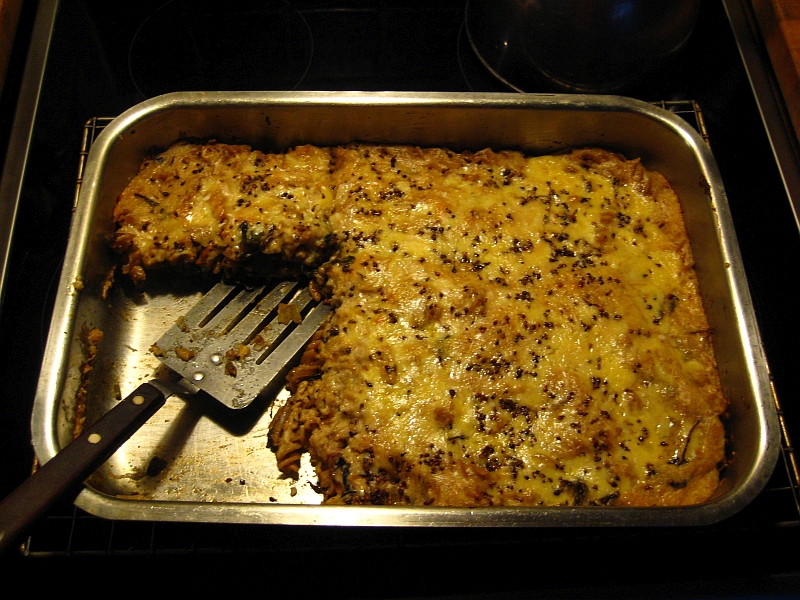 The plants:
The plants:
Forced inside:
Aralia cordata (udo)
Hosta
Aegopodium podogaria (ground elder / skvallerkål)
Cichorium intybus “Witloof Væres Venners” (chicory / sikori)
Allium senescens x nutans
Petroselinum crispum (parsley / persille)
Brassia oleracea (various perennial kales / flerårige kål)
Cirsium oleraceum (cabbage thistle / kåltistel)
Outside:
Allium carinatum “Pulchellum”
Hablitzia tamnoides (Caucasian spinach / stjernemelde)
Allium stipitatum shoots (Persian shallot / Persisk sjalott)
Rumex acetosa “Abundance” (sorrel /engsyre)
Taraxacum sp. (dandelion / løvetann)
Alliaria petiolata (garlic mustard / løkurt)
Dystaenia takesimana
Scorzonera hispanica (scorzonera / scorsonerrot)
Ranunculus ficaria var chrysocephalus (lesser celandine / vårkål)
Cardamine raphanifolia
Hemerocallis sp.
Allium cernuum (nodding onion / prærieløk)
Allium oleraceum (wild onion / villøk)
Allium sativum (garlic / hvitløk)
Allium paradoxum var normale
Allium paradoxum var paradoxum (few-flowered leek)
Armoracia rusticana ( horseradish / pepperrot)
Smyrnium olusatrum (alexanders / sorte løpstikke); not a very hardy species, but I’ve kept it alive for many years growing up against the house wall protected by a leaf and sacking mulch (I overwinter tender plants in pots here):
Dandy Lion Quiche
Happy Dandy Lions forced in the living room, glad to have been invited into the warmth. Little do they know though that I had a cruel plan to put them into last night’s quiche!
Quiche is one of some 20 generic dishes I’ve evolved over the years for using perennial veg as there are no recipes for the veggies I grow. As always, we use coarse whole grain flour (organic emmer wheat and svedje rye flour). We also used forced Allium senescens onions and leeks and swiss chard from cold storage in the cellar as well as garlic and rehydrated winter chantarelles. Super tasty and healthy!


A conventional salad!
I didn’t know if I could make a salad just with ingredients you can buy in the supermarket (but all home grown of course!), but last week I DID IT when I had a family visit!!
The picture of me looking cool and conventional with my favourite grandson Johannes was taken by favourite son Robin (yes, I have one of each)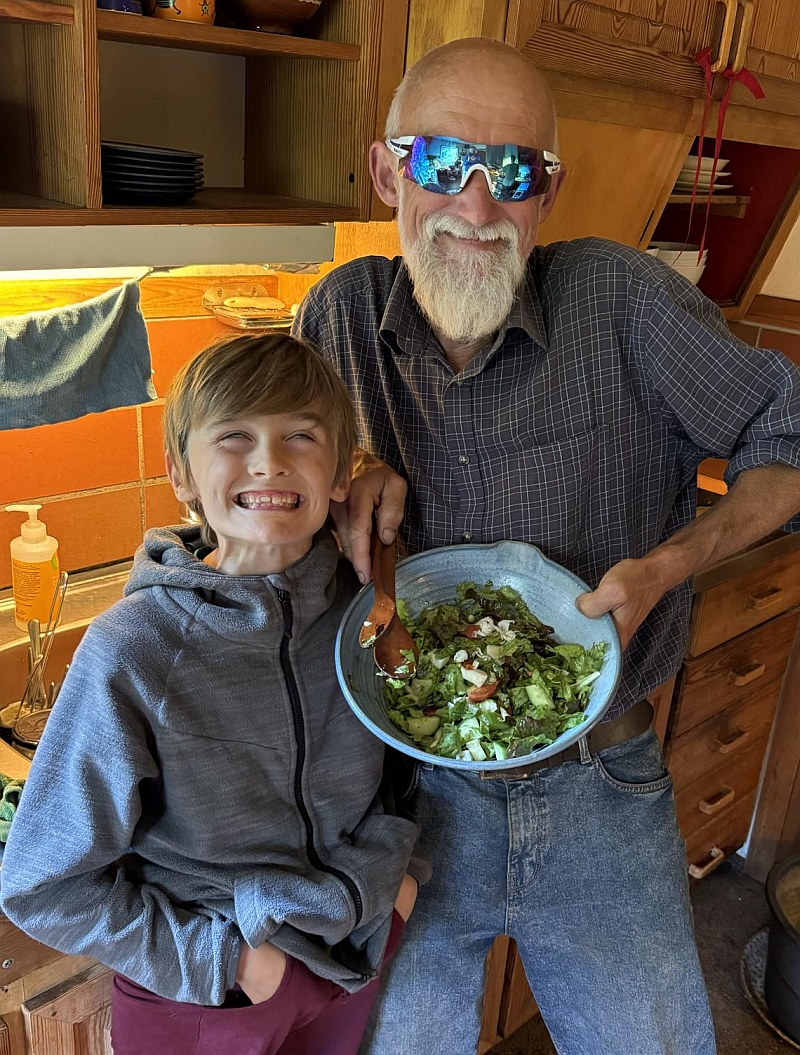
Sochan and Moly scrambled egg Meditteranean style
Lunch today was inspired by the Mediterranean diet – simple with masses of greens, but with an international twist: Cherokee spinach (top shoots of sochan – Rudbeckia laciniata / kyss-meg-over-gjerde), nettles (nesle), shallots (sjalott) harvested and stored since October, greater musk mallow (rosekattost) (Malva alcea), day lilies (dagliljer) flower buds, sand leek (bendelløk) (Allium scorodoprasum) and nodding onion / prærieløk (Allium cernuum) flowers. Added wild oregano (Origanum vulgare), dried orange milkcap / Granmatrisken (Lactarius deterrimus) and home grown chili salt a la “Are Sende Osen” (a gift during his visit this week), served with Allium moly flowers (from the mountains of Spain).

